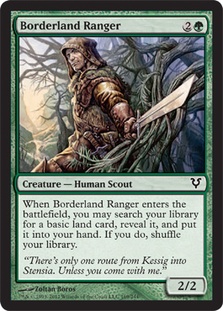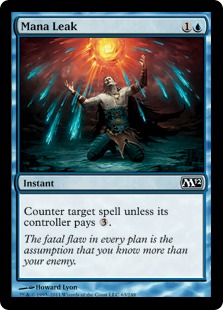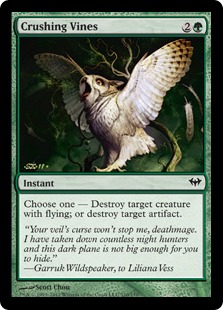Calling G/R Aggro an aggro deck is a bit of a misnomer, as it falls under the traditional categorization of midrange. The original build of the deck was playing Hellriders while other G/R decks were all-in on Primeval Titans, which makes it look like an aggressive deck. However, the newer iterations are playing less Skizziks and more Loxodon Hierarchs.
A brief aside: Can you believe that Elephant used to be a format-defining card? Thragtusk and even Huntmaster just make it look embarrassing. And then you go further back to Ravenous Baloth. You don’t even get your life gain up front, and you don’t have the utility of Loxodon Hierarch’s rarely used sacrifice ability. It’s gotten to the point that the creatures being printed are just flat out silly. There’s no other word for it. Have you read Thragtusk? Good lord…
The lines between archetypes have been blurred into a mush of ill definition. Basically, what I am saying is that the name of the deck shouldn’t affect how it’s perceived or played. By traditional standards, this is solidly a midrange deck: you’re using mana accelerants to play grindy board presence and pseudo card advantage creatures.
The following principle is most pronounced in the quintessential matchup of today’s metagame: G/R “Aggro” versus Delver.
Magic is at a place where pretty much every game of Standard is about developing tempo and slight card advantage/selection advantages early, but those edges are pretty small and ultimately come to a convergence point of a gimmicky race. By that I mean that it is less of a traditional race, as both sides are equipped with multiple substantial haymakers for just such an occasion. These include but are not limited to:
- Equipment, both Pikes and Swords
- Hasty creatures
- Life gain in the form of Huntmaster of the Fells and Thragtusk (and, as always, Green Sun’s Zenith for them)
- Flash creatures to disrupt combat: Snapcaster Mage and Restoration Angel
- Unbelievably cheap and efficient removal: Dismember, Gut Shot, and Vapor Snag (along with rebuys)
- Bonfire of the Damned (LOL)
What I’m saying is that the two decks are basically built for exactly this scenario. So let’s talk a bit about how our deck is built and then go a bit into how the matchup plays out.
The card that puts this deck over the top is the overwhelmingly powerful Green Sun’s Zenith. Banned in Modern and a staple in Legacy, this is the card that drives the deck. The key to building with something like GSZ is to not go overboard, to not succumb to the danger of cool things.
As I played more with the deck, one deckbuilding decision I found myself making over and over was the cutting of utility creatures. My starting list was:
Creatures (25)
- 4 Llanowar Elves
- 4 Birds of Paradise
- 1 Acidic Slime
- 2 Borderland Ranger
- 1 Thrun, the Last Troll
- 4 Strangleroot Geist
- 4 Huntmaster of the Fells
- 2 Wolfir Silverheart
- 1 Druid's Familiar
- 2 Thragtusk
Lands (23)
Spells (12)

The Acidic Slime was cut immediately, followed by Mr. Thrun, then the second Thragtusk, and eventually the Druid’s Familiar. The situations where I actually wanted to find one of them badly enough that it was significantly impactful on the outcome of the game that the option wasn’t available to me were so few and far between that it didn’t even begin to justify their inclusion in the deck. So often they would merely clog my hand with expensive drops that weren’t as lean and efficient as the other things that I could be playing. Of all the things you could Zenith for, is a Druid’s Familiar really what you want to be getting?
Borderland Ranger immediately stood out as an important bridge in the flow of the deck’s curve. It gives you something to play on turn 2 that isn’t embarrassing on turn 3 that helps set up your fours and fives. It is big enough to threaten to trade with Geist of Saint Traft and trade with the likes of Snapcaster and Solemn Simulacrum for minimum losses. It is a warm body to play into a Leak that would otherwise hit your Huntmaster, and you still have something that can’t be spiked by a Gut Shot to put your Sword on to. The deck is never short of things to do with excess mana, what with the high curve, the multiple X spells, and the Kessig Wolf Runs. Borderland Ranger is just a solid two for one that perfectly fills a lot of the deck’s needs. He slices, he dices, etc.
As mentioned, the deck handles flooding very nicely. That is why you can get away with 23 lands, eight mana guys, three or four Borderland Ranger, and still want to Zenith for them on occasion. There’s also the fact that, in the land of Gut Shots and the like, the odds of your accelerator surviving too long are pretty low.
The deck wants to get into favorable racing situations. Pushing out an early Huntmaster is a great way to put yourself in a position to force your opponent into a bad race. This is because there are very few things that answer Huntmaster without giving up significant value or potential value. That means that their resources are often better spent trying to kill you while minimizing their losses at the hands of your flippy four-drop. Once the perimeters of the race are set, you have more ways to turn the tides in your favor.
The reason that G/R can lose to Delver is that the blue-based aggro-control deck has more ways to push their early game tempo and put G/R on the back foot. Then G/R has to assume a sort of control role, which it is not as suited to do as it is to race. The only way that you can get out from under a good start from a Delver player (especially on the draw) is by landing a lucky Bonfire—miracled or having them caught without a counter—or by using one of your precious spot removal spells (Dismember main, Combusts and the like post-board) in a key spot to regain a large portion of the tempo that the Delver player exhausted so many resources to acquire.
All of this jockeying then leads to the mid game, haymaker semi-race. If you had to use a spot removal spell early, then you may not have one for a key Restoration Angel, a Talrand, Sky Summoner, or for a big tempo swing by negating a turn’s worth of mana and attack by killing a creature equipped with a Runechanter’s Pike.
All the early game jockeying does is set up the mid game, and determining how that is shaped helps define for the players who is ahead and what needs to be done to close it out/recover.
This assumes that the early game positioning doesn’t swing too heavily in one direction, as both decks (although I have to say, Delver more so than G/R) have the potential for draws that can be near impossible to answer. This nut drawing is a fairly low percentage of games and happens almost exclusively from the play, as being a half of a land behind is usually enough for the opponent to prevent the initial tempo push from outright winning the game.
The “free wins” from Delver nut draws are no different than the free wins granted by miracling a Bonfire of the Damned or landing an early Sword against a removal-light hand. Free wins are just part of Magic, now more so than ever before, and all you can do is ride the variance out. Try and maximize your percentage of free wins and minimize your opponents’ and then outplay them in the games where you are both fighting on close to even footing.
Mana Leak is a card that acts as a pivot point for a lot of the games that could have been won or lost to go one way or the other. While G/R has the burden of having to play around/through one of the most efficient pieces of countermagic to date, the Delver player has the burden of having a few of these reactive tempo cards that don’t affect the board in their deck clogging up their hand.
From the G/R perspective, I think that a large majority of the time players should be playing directly into Mana Leak. All too often I will see players hold their creatures, futilely hoping their opponent will randomly tap out. This is obviously incredibly unlikely, as they have plenty of instant speed threats and can produce a lot of pressure out of nowhere (end step, Restoration Angel, untap, Runechanter’s Pike, equip, and swing can end games very quickly seemingly out of nowhere).
What this means is that you want to put them to the test. More often than you’d expect, they just stone don’t have it (Delver players keep cutting more and more of them these days) and you’ll easily take a nice lead. Even if they do have it, chances are it was going to counter something eventually anyway, as you were going to have trouble getting to seven or eight mana in order to threaten to pay the toll.
There are obviously exceptions—for one, when you’re going to play your seventh land the next turn anyway, you should probably just hold your Huntmaster of the Fells for a turn—but, as an exercise, I want you to try just jamming your Huntmasters and what have you blindly and observe the results. You may be impressed.
That being said, one sequence that is particularly punishing is a turn 3 Mana Leak (especially if they were able to utilize their spare mana with a one-drop of some sort) and then Snapcaster Mage flashing that Mana Leak back the following turn. This is the sort of quintessential backbreaking tempo sequence that Delver is so good at producing. Playing around this could be as simple as not running your best creature into the front side of the Mana Leak so that the opponent is put to the choice between breaking up his clean and profitable sequence or “wasting” a counter on an inferior creature. (From the Delver side, it is almost always worth going through with the Leak, Snap–>Leak line).
This is the role that Borderland Ranger often plays. If they counter it, then they are potentially leaving themselves open to your army of Loxodon Hierarchs. However, if they don’t, then not only do you have a board presence, but you are up a land, giving their Mana Leak a smaller likelihood of nabbing what they want it to. There is an invisible clock on the life of a Mana Leak where when you reach a certain point in the game they just cease to be relevant. If they want to let you play your Borderland Rangers, then you can simply hit your land drops and let the Leaks rot in their hand.
With a fair number of potent low-drops, it is completely reasonable to strand them with Leaks if they aren’t putting any pressure on you. Pumping all of your mana into a Kessig Wolf Run is a great way to spend a turn’s mana without exposing a spell to a counter. This is especially true if you are using it on a creature that it either doesn’t matter if they Vapor Snag it (Strangleroot Geist) or one that is actively bad to bounce (Borderland Ranger, Huntmaster of the Fells).
The last thing I’m going to say about playing against Mana Leak is to be wary of turns where a Restoration Angel would be scary. For example, say the opponent has a Snapcaster Mage in play, a Vapor Snag in the graveyard, and five or six mana in play. This is a situation where you likely just want to play your best spell. That way, the opponent either wastes his turn’s worth of mana countering it or you have your strongest spell resolve so their Angel sequence isn’t as devastating.
There are a lot of sideboard options from both sides. Basically, people are boarding poorly because they assume the matchup plays out the same way it did in game 1, but this is not the case. There are a few slight variations in the convergence points that the games come to and how you should try to gain your advantage.
Both decks slow down a fair amount and there are far less free wins in post-board games, as each build is more prepared for opposing nut draws. This means that the games tend to grind out more. Delver has more defensive cards such as Timely Reinforcements and removal in the form of Oblivion Ring and/or Celestial Purge.
The G/R player gets access to artifact removal ala Ancient Grudge and the double-duty Crushing Vines as well as more spot removal with Combust / Crushing Vines at a minimum. These two factors make sticking equipment and getting hits in extremely difficult, which makes it much harder for Delver to pull off any major mid game sequences to swing a race in their favor. G/R was already better suited for that kind of a game, and now it is even better plus the games are more likely to end up there!
Delver ends up winning two types of post-board games against G/R: early game pressure and late game stabilization. The standard tempo draw with undercosted threats backed by efficient tempo cards is still a real thing. An early Delver flip can force the G/R player into spending one of his precious spot removal spells on it, only to have a Geist of Saint Traft Blinked to safety by a Restoration Angel that then gets to join the fun as the G/R player stares at his Combust already in the graveyard. These games usually end with a crescendo on turn 5 or 6 with a flurry of Vapor Snags and Snapcaster Mages to clear the way and essentially burn the opponent out.
The other type of game Delver ends up winning is by getting into the late game with a significant lead. This happens by trading profitably with G/R’s threats and then simply having a higher density of threats as well as better card selection while transitioning out of the mid game. These draws often involve countermagic for things like Thragtusk and Huntmaster of the Fells. This type of strategy is actually pushed more heavily by some Delver players and led to the development of Delverless Delver and Sam Black U/W Midrange build. You’ll still see sideboard plans with Gideon Jura and the like.
The late game is what those builds are aiming to play, but that doesn’t mean that a more aggressive version can’t accomplish this as well; it’s just very difficult as you need a very specific run of cards that must match up properly with the opponent’s draw. If you have a hand full of Gut Shots and they have the Ranger, Huntmaster, Thragtusk draw, then you’ll probably just die. If you have countermagic and they have the mana guys, Strangleroot Geist, Sword draw, then you’ll probably just die. This is why it’s important to have flexible cards and to be prudent with your card selection.
Next week, I’m going to have an AJTV about this subject and go over examples of the principles I discussed today and some finer aspects of the matchup. Thanks for reading!
And, as always, check out my stream at twitch.tv/ajsacher



